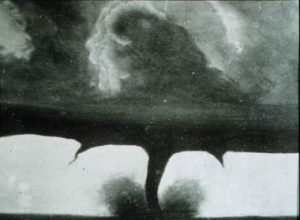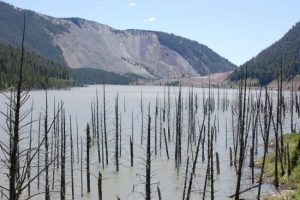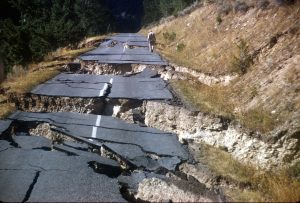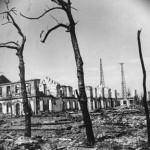loss of life
 These days, tornado watches and warnings are a normal part of life. They may not happen every day, but when they do sound, we know what to do to stay as safe as possible. The warnings don’t always mean that there are zero deaths from a tornado, but they do help. Unfortunately, the tornado warning sirens, Doppler radar, and television warnings did not exist in 1884. In those days, people had to rely on the skies to tell them what was coming, and as most of us know, that is not always an easy task. In fact, it has taken hundreds of years to even begin to come close to perfecting a system whereby the public could be warned of approaching severe weather, and even then, it hasn’t eliminated the deaths that can occur from these storms.
These days, tornado watches and warnings are a normal part of life. They may not happen every day, but when they do sound, we know what to do to stay as safe as possible. The warnings don’t always mean that there are zero deaths from a tornado, but they do help. Unfortunately, the tornado warning sirens, Doppler radar, and television warnings did not exist in 1884. In those days, people had to rely on the skies to tell them what was coming, and as most of us know, that is not always an easy task. In fact, it has taken hundreds of years to even begin to come close to perfecting a system whereby the public could be warned of approaching severe weather, and even then, it hasn’t eliminated the deaths that can occur from these storms.
One of the largest and most widespread tornado outbreaks in American history happened at a time when warnings did not exist. It happened on this day February 19, 1884, and into February 20, 1884. The precise number of tornadoes, as well as fatalities incurred during the outbreak remains unknown. The outbreak was nicknamed “Enigma outbreak” and is well known by that name. Research of newspaper reports and governmental studies published in the aftermath reveals tornadoes, or in reality, long-track tornado families, struck Alabama,  Georgia, Illinois, Indiana, Kentucky, Mississippi, North Carolina, South Carolina, Tennessee and Virginia. It is estimated that at least 50 tornadoes struck those states that day. Some events that had been counted as tornadoes in initial studies, such as those by John Park Finley, were actually downbursts, especially in northern and northeastern portions of the outbreak. Nevertheless, the damage done was nothing to be overlooked.
Georgia, Illinois, Indiana, Kentucky, Mississippi, North Carolina, South Carolina, Tennessee and Virginia. It is estimated that at least 50 tornadoes struck those states that day. Some events that had been counted as tornadoes in initial studies, such as those by John Park Finley, were actually downbursts, especially in northern and northeastern portions of the outbreak. Nevertheless, the damage done was nothing to be overlooked.
The majority of the reported tornadic activity was seen across Alabama, Georgia, South Carolina and North Carolina, which were all struck severely by multiple waves of tornado families. In the Southeast, the outbreak began during the late morning in Mississippi, preceded by severe thunderstorms in Louisiana. Shortly thereafter, the outbreak widened and intensified, progressing from Alabama to Virginia between noon and midnight. In addition to the outbreak, wind damage, flash floods, with homes swept away by water in Louisville, Kentucky, New Albany, Indiana, and Jeffersonville, Indiana and other towns along the Ohio River, and Derecho-like effects in the Ohio Valley were also reported in published accounts of the outbreak. In case you didn’t know, a Derecho is a widespread, long-lived, straight-line wind storm that is  associated with a land-based, fast-moving group of severe thunderstorms. In addition to that, blizzard conditions occurred in the eastern Midwest, as a part of this storm series. According to an article appearing in the Statesville, North Carolina Landmark three days later, the damage tally in Georgia alone was estimated to be $1 million, in 1884 dollars. Today, the damage would have been approximately $23,660,667. That is an astounding figure, and that is just the property damage numbers. Loss of life simply cannot be measured in money. In fact, the greatest mystery surrounding this horrific event is the possibility that, in all likelihood, as many as 1,200 people lost their lives that day at the hands of the 1884 Enigma Tornado Outbreak.
associated with a land-based, fast-moving group of severe thunderstorms. In addition to that, blizzard conditions occurred in the eastern Midwest, as a part of this storm series. According to an article appearing in the Statesville, North Carolina Landmark three days later, the damage tally in Georgia alone was estimated to be $1 million, in 1884 dollars. Today, the damage would have been approximately $23,660,667. That is an astounding figure, and that is just the property damage numbers. Loss of life simply cannot be measured in money. In fact, the greatest mystery surrounding this horrific event is the possibility that, in all likelihood, as many as 1,200 people lost their lives that day at the hands of the 1884 Enigma Tornado Outbreak.
 I read in the paper on Monday about the 57th anniversary of the August 17, 1959 Hebgen Earthquake that created Earthquake Lake in Montana, just west of Yellowstone National Park. The 7.5 magnitude earthquake was the second strongest quake in the lower 48 states in the 20th century, according to the United States Forest Service, killing 28 people, including five people in one Idaho Falls family who were entombed in the ensuing landslide, and are still there to this day. I was only three years old when that quake occurred, so I wouldn’t remember it, nor am I aware that it was felt in Casper, Wyoming, where we live, although it might have been felt there too. Still, I doubt I would have remembered it.
I read in the paper on Monday about the 57th anniversary of the August 17, 1959 Hebgen Earthquake that created Earthquake Lake in Montana, just west of Yellowstone National Park. The 7.5 magnitude earthquake was the second strongest quake in the lower 48 states in the 20th century, according to the United States Forest Service, killing 28 people, including five people in one Idaho Falls family who were entombed in the ensuing landslide, and are still there to this day. I was only three years old when that quake occurred, so I wouldn’t remember it, nor am I aware that it was felt in Casper, Wyoming, where we live, although it might have been felt there too. Still, I doubt I would have remembered it.
What I do remember, is the trip our family took when I was a child, that included Earthquake Lake. I don’t recall whether I was told about the 28 people who died there, or the ones they never found, but I rather doubt  it, because things like that tend to be something that sticks with me…even really bothering me when I was younger, because I almost felt like I was a trespasser on their graves. These days, I realize that being near someone’s grave, whether in a cemetery or a natural grave such as Earthquake Lake became, is still nothing more than a final resting place. What impresses me more now is the sadness of the loss. That family was on vacation, and suddenly their lives were gone…over in an instant. Along with the loss of life, there was the damage to roads, making it even harder to bring help in to the people who were trapped, although I’m not sure it would have made much difference.
it, because things like that tend to be something that sticks with me…even really bothering me when I was younger, because I almost felt like I was a trespasser on their graves. These days, I realize that being near someone’s grave, whether in a cemetery or a natural grave such as Earthquake Lake became, is still nothing more than a final resting place. What impresses me more now is the sadness of the loss. That family was on vacation, and suddenly their lives were gone…over in an instant. Along with the loss of life, there was the damage to roads, making it even harder to bring help in to the people who were trapped, although I’m not sure it would have made much difference.
I remember feeling the enormity of the catastrophic event that took place that day a number of years earlier. I was impressed by the ability of an earthquake to change the face of the landscape around it. What had been the Madison River, was blocked by a massive landslide creating Earthquake Lake. The deaths were random. A couple, Edgar and Ethel Stryker were killed by a boulder that crushed them, while their three young sons,  sleeping in a nearby tent, were unhurt. Irene Bennett and her son Phil were saved, but her husband Purley and their three other children were killed. Myrtle Painter died of her injuries, while her 16 year old daughter Carole survived. That was the story of the event, this one died, and that one lived. I think that while I probably didn’t know about all those deaths, that I still felt the sadness of that place, because it is a place I have never forgotten. An earthquake that happens in a rural area seems to make us think that it was simple a change of the landscape, but that is rarely the case. It seems that there are almost always a few people in the area, and that means a loss of life. A very sad event indeed.
sleeping in a nearby tent, were unhurt. Irene Bennett and her son Phil were saved, but her husband Purley and their three other children were killed. Myrtle Painter died of her injuries, while her 16 year old daughter Carole survived. That was the story of the event, this one died, and that one lived. I think that while I probably didn’t know about all those deaths, that I still felt the sadness of that place, because it is a place I have never forgotten. An earthquake that happens in a rural area seems to make us think that it was simple a change of the landscape, but that is rarely the case. It seems that there are almost always a few people in the area, and that means a loss of life. A very sad event indeed.
 Anytime humans go to war, the one sure outcome is loss of life. That is just a fact of war. Of all the wars that the United States has been involved in, World War II interests me the most, because of my dad’s involvement, I’m sure. War is a brutal activity, but with the evil in the world, it is sometimes necessary. Evil nations leave us no choice but to step in. Such was that case with World War II, and Japan. On this day, March 9, 1945, the United States warplanes launched a new offensive against Japan. The campaign carried out involved dropping 2,000 tons of incendiary bombs on Tokyo over a two day period. Almost 16 square miles in and around the city were incinerated, and between 80,000 and 130,000 Japanese civilians were killed in the worst firestorm in recorded history.
Anytime humans go to war, the one sure outcome is loss of life. That is just a fact of war. Of all the wars that the United States has been involved in, World War II interests me the most, because of my dad’s involvement, I’m sure. War is a brutal activity, but with the evil in the world, it is sometimes necessary. Evil nations leave us no choice but to step in. Such was that case with World War II, and Japan. On this day, March 9, 1945, the United States warplanes launched a new offensive against Japan. The campaign carried out involved dropping 2,000 tons of incendiary bombs on Tokyo over a two day period. Almost 16 square miles in and around the city were incinerated, and between 80,000 and 130,000 Japanese civilians were killed in the worst firestorm in recorded history.
Early that morning, Air Force crews met on the Mariana Islands of Tinian and Saipan for a briefing. This would be a low level bombing attack on Tokyo beginning in the evening, but this one would be different. The planes would be stripped of all guns except for the tail turret. This would decrease the weight…increasing the speed of  each Superfortress bomber. This also increased the bomb load capacity by 65 percent. Now each plane could carry more than seven tons of bombs. The most crucial thing, however, would be speed. If the plane didn’t make it out of the city, the airmen were warned to get to the water as fast as they could, because their very lives depended on it. Staying in the city would mean a fiery death, because they were going to be delivering the biggest firecracker the Japanese have ever seen.
each Superfortress bomber. This also increased the bomb load capacity by 65 percent. Now each plane could carry more than seven tons of bombs. The most crucial thing, however, would be speed. If the plane didn’t make it out of the city, the airmen were warned to get to the water as fast as they could, because their very lives depended on it. Staying in the city would mean a fiery death, because they were going to be delivering the biggest firecracker the Japanese have ever seen.
The first location would be the suburb of Shitamachi, which was composed of roughly 750,000 people. The destruction of Shitamachi would destroy the light industries, called “shadow factories,” that produced prefabricated war materials for Japanese aircraft factories. The citizens of Shitamachi never had a chance against the Superfortress B-29 bombers. Their fire brigades were undermanned, poorly trained, and ill equipped. All the people could do was to run from the inferno that the city had become. The planes…334 in all, came in a just 500 feet above the ground. Most of them didn’t make it. Doctors said, “The human carnage  was so great that the blood-red mists and stench of burning flesh that wafted up sickened the bomber pilots, forcing them to grab oxygen masks to keep from vomiting.”
was so great that the blood-red mists and stench of burning flesh that wafted up sickened the bomber pilots, forcing them to grab oxygen masks to keep from vomiting.”
The entire raid lasted just a little longer than three hours. When it was over the Sumida River was clogged with bodies of the dead, burned beyond recognition. The sight was beyond anything anyone could have imagined. The loss of American lives was a mere 243 airmen, and these were considered to be acceptable losses. I suppose that these days, such a raid on known civilian targets would be considered unacceptable, but at the time it was considered acceptable, and even necessary. And it was successful, in a horrible sort of way.

